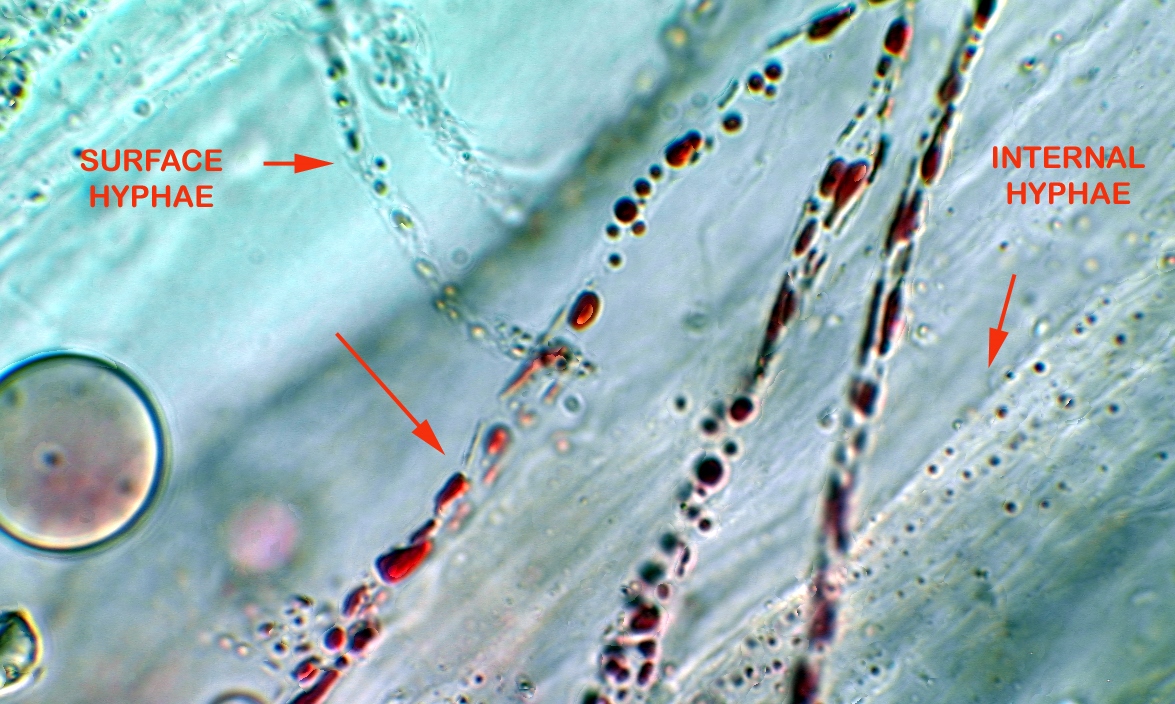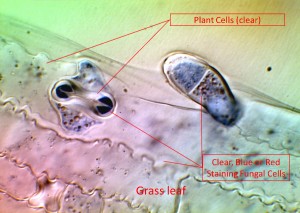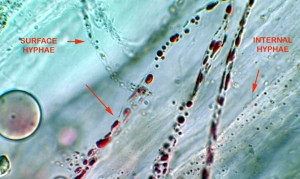I recently had a fascinating talk with Dr. Mary Lucero, a former USDA molecular biologist who now works to restore food systems by restoring microbial health.
Mary’s work and knowledge confirms to me the absolute necessity for diverse microbial communities in our agricultural systems, if we are to produce nutritious, chemical free food. Mary’s particular area of interest has been plant and soil fungi. Fungi are not just a ‘choice’ extra that might be nice to have in our farm systems, but are an integral part of healthy plants.
Mary shared with me this photograph below[private], (by the late Dr. Jerry Barrow also of USDA), showing a magnified, stained section of a plant leaf surface. The long, rectangular, clear cells are from the plant, as are the long, banana shaped guard cells surrounding the pore, or stomate, in the upper right. The blue or red staining regions, including the large teleospore protruding from the leaf represent fungi, as do the clear, wavy, string-like hyphae that lay between plant cells. Why have I shared this picture and quite technical explanation of plant cells and fungi? Even if you aren’t familiar with all the plant components, it illustrates to us how tightly integrated the fungi and plant are.
Because fungal hyphae weave networks throughout the plant and soil, fungi can theoretically transport nutrients several kilometres to feed plants. They exchange these nutrients for sugars, which are made by the plant – a relationship I have spoken of before. Plant and fungal enzymes convert the sugars to high energy lipids for efficient storage and transportation. When fungi are removed from the soil by tillage, chemicals, or other disturbances, the plant is unable to acquire the nutrients it needs. I think we are often unaware of the really vast services that fungi perform for us in our farm and plant communities. Given that it is sometimes difficult to distinguish where the plant ends and the fungi begins, maybe some of their functions, like the role they may have in regulating water loss or defending plants from pests, are often wrongly attributed to the plant alone.
Soils ecologist Christine Jones describes the energy needed for us to improve and maintain flourishing agricultural systems begins as light from the sun. The light energy then has to pass through two bridges before it will restore our soils, plants and agricultural communities.
- The photosynthetic bridge – where light energy from the sun becomes biochemical energy (carbon compounds or plant sap).
- Microbial Bridge – where biochemical energy (carbon compounds) becomes soil microbial intermediaries.1
If either the photosynthetic bridge or the microbial bridge (including fungi) is ‘broken’, then the system will not function as it should. What Mary’s research illustrates is that these photosynthetic and microbial bridges are neatly intertwined with one another throughout the plant and soil system. Damage to either one can result in poor plant health, less nutrient dense food production and systems that are less resilient to stress and pest attack.
I would like to share with you a couple of ways that fungi integrate with our plant communities, to help our crops and pastures to have this resiliency, which is increasingly necessary in our changing climate.
The importance of fungi in plant pest resistance
Work that Mary was involved with looked at the microhairs on the leaves of a number of C4 native pasture grass species. These microhairs – associated with all C4 grasses and illustrated below, were previously considered to be a structural part of the plant leaf. Working with the late Dr. Jerry Barrow, Mary’s research team discovered that what were thought to be leaf hairs were actually derived from the fungi that were integrated with the leaf. The association between the fungi and leaf suggests that the fungi may have co-evolved with C4 grass plants.2
One way these two-celled fungal microhairs may serve the plant is by releasing volatiles when the leaf is attacked by insects. Volatiles are small chemicals that can move rapidly through the air, signalling to insect predators that a plant is under attack and hence an insect pest must be present. The predator insect is guided by the volatile to the place of the insect attack – where the pest is ‘devoured’ by the predator. These plant volatiles (essential oils) were thought to come from plant glands at the base of leaf hairs. Mary’s work challenges the assumption that plant cells are exclusively responsible for the volatile production. It is possible that endophytic fungi may be involved.
Fungi and plant resilience in dry times
Mary’s research has led her to believe that microbial dense and diverse soil communities better support plants in dry times. Her home state of New Mexico often has boom and bust weather events; very dry times, followed by storm build ups at certain times of year and big rainfall events. So, plants typically do very little during dry times, but upon the big rainfall events, the plants’ growth occurs dramatically quickly.
Living things contain mechanisms known as feedback inhibitions, which can come into play during these high growth times. These are feedback mechanisms that regulate certain pathways – so for instance, if photosynthesis occurs at a rapid rate – as it would after big rains, the production of sugars from photosynthesis increases dramatically. If too much sugar accumulates, the biofeedback system of the plant kicks in and reduces sugar production, slowing growth to a manageable rate. The frequent detection of fungal hyphae wrapping themselves around the chloroplasts (where photosynthesis/sugar production occurs) of healthy, actively growing plants, combined with the observation of dense lipid bodies associated with fungal hyphae suggests fungi may be intercepting this biofeedback mechanism by capturing sugars, converting them to lipids, and transporting them to other regions of the plant or soil.4 (The image below shows long, thin fungal hyphae filled with red-staining lipid bodies on the surface of plant cells).
When moisture or other conditions limit production of photosynthetic carbon, the plant and the microbes it supports could be utilizing carbon stored by the fungi as lipids – helping the plant to survive the dry times. This concept is extremely difficult to demonstrate unequivocally and presents fungi as mutualistic (ie. both plant and fungi benefit), rather than pathogenic (where just the fungi would benefit) and as a highly beneficial component to the system.
This explanation starts to give us some idea of why we can have improved water use efficiencies and better crop performance in dry times when plant and microbial diversity is utilised in our farming systems. It goes some way to explain the wonderful results some farmers are receiving in dry seasons following diverse cover crops and in diverse perennial pastures.
The Importance of Fungi
The above examples give us some idea of the varied ways in which fungi help us in agriculture – and the way in which we lose the plant’s natural defense mechanisms against pests, diseases and dry times when we disrupt either the plant or the soil microbiome. The use of petrochemical fertilisers, fungicides and pesticides can all contribute to this disruption of the microbiome. The known benefits of fungi are vast – and I’m sure we currently know only a fraction of the things they are doing!
One of Mary’s colleagues, David Johnson explains the system well.
“Soils evolve. A plant grows, which influences the soil and increases carbon content (through root exudates). Soil organisms depend on energy, and as we add more energy (as plant sugars), we increase the population density in the soil. The addition of still more energy changes the population structure of soil, diversity begins and so too does specialization. Still further energy addition to the system results in mutualism between plants and soil microbes”.3
It starts with adding energy as sunlight via photosynthesis but then relies on the microbial bridge as described by Christine Jones. The good news is that many of these fungi spores are blowing around in the wind – readily accessible to us all and to our paddocks. We just have to nurture the right environment so that they can proliferate and contribute the help for which they have evolved.
References
- Jones, C. (Sept 2013) From Light to Life; restoring farmland soils. WANTFA New Frontiers in Agriculture. http://www.amazingcarbon.com/PDF/JONES-NewFrontiersInAg(Sept13).pdf
- Barrow, J. Lucero, M.et al. (2007) Endosymbiotic fungi structurally integrated with leaves reveals a lichenous condition of C4 grasses. In Vitro Cellular and Developmental Biology – Plant 2007 43 (1), 65-70
- Johnson D, Ellington J, Eaton W. (2015) Development of soil microbial communities for promoting sustainability in agriculture and a global carbon fix.PeerJ PrePrints 3:e789v1 https://dx.doi.org/10.7287/peerj.preprints.789v1
- Osuna Avila, Pedro; R. Barrow, Jerry; E. Lucero, Mary; Aaltonen, Ronald E. Relationship between Plant Lipid Bodies and Fungal Endophytes. Terra Latinoamericana, vol. 30, núm. 1, enero-marzo, 2012, pp. 39-45, available online at http://www.redalyc.org/pdf/573/57324651005.pdf



